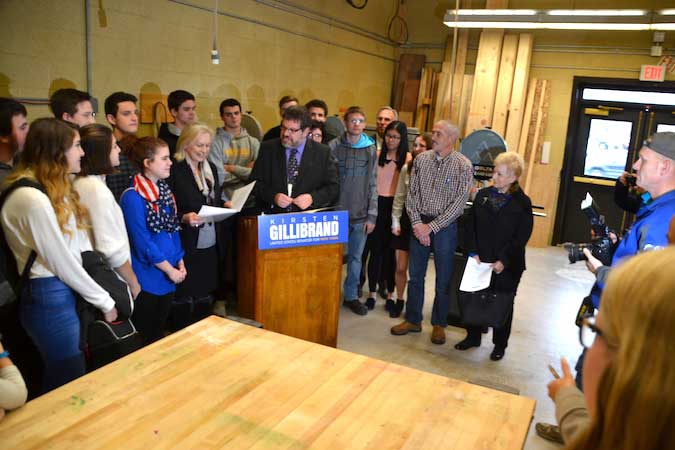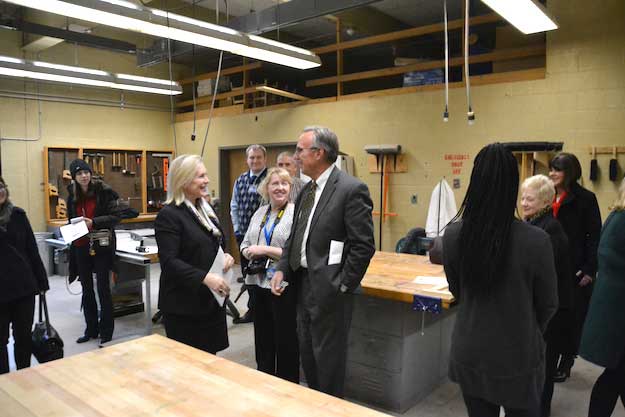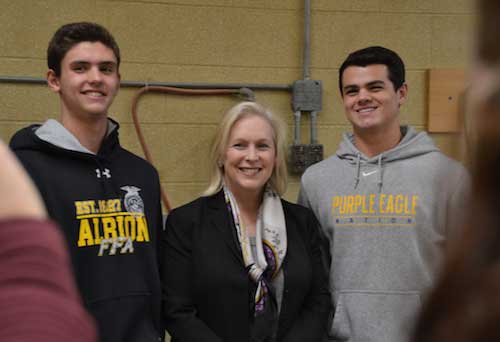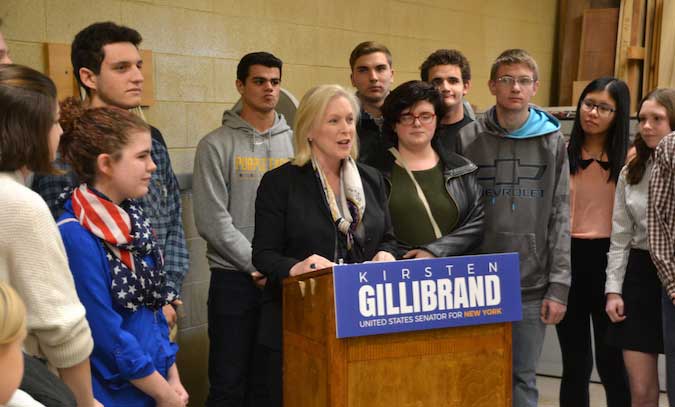Gillibrand visits Albion school to promote new technology for shop classes
ALBION – U.S. Sen. Kirsten Gillibrand said high school graduates with skills in the trades can expect to land good-paying jobs right out of school, especially if they learn how to use 3D printers, laser cutters, and computerized machine tools.
The problem, Gillibrand said, is many schools don’t provide training on the latest equipment.
She has teamed with other senators to propose the “21st Century Strengthening Hands On Programs that Cultivate Learning Approaches for Successful Students Act.” The bipartisan legislation would make federal funding available for more equipment in Career and Technical Education programs and also boost teacher training, so instructors could teach students how to use the equipment.
Gillibrand said the program is critical to match students with the needs in the workforce. Many businesses and manufacturers are struggling to find qualified employees, she said.
“I know shop class is always a favorite because it is fun, it’s a change of pace from your everyday studies and you learn important skills that can help you in your careers,” Gillibrand said at Charles D’Amico High School in Albion. She was joined by many high school students.

Michael Bonnewell, the Albion Central School superintendent, introduces Gillibrand on Monday afternoon.
“These jobs are very important that we rely on every single day, whether it’s an engineering job, whether it’s help to repair after a hurricane like we’re seeing in Puerto Rico, whether it’s a high-tech manufacturing job here in Western New York,” Gillibrand said. “In the Senate, one of the most important responsibilities that I have is to make sure when you graduate from high school you actually have the skills you need to get that job that you want. But there are a lot of companies throughout our state and country that have job openings with good salaries for graduates in programs like this but sometimes they can’t fill those jobs. So there is a skills gap that we need to fill to make sure our students are the ones to get those jobs.”
U.S. Senator Todd Young (R-IN) is a cosponsor of the bill with Gillibrand. The legislation would amend the Perkins Career and Technical Education (CTE) Act to give greater priority to funding for maker education, makerspaces, and training for teachers in the application of maker education.
“Our students should be able to take many different paths in order to get a good job and earn a good salary, and this bill would help equip more students with the skills they need to get on a path toward good-paying high-tech jobs when they graduate high school,” she said.

U.S. Sen. Kirsten Gillibrand meets Joe Steinmetz, director of Career and Technical Education at the Orleans/Niagara BOCES.
She was joined in Albion by Joe Steinmetz, director of CTE and adult/secondary programs for the Orleans/Niagara BOCES.
The Career and Technical Education programs at the Orleans/Niagara BOCES have grown 10 percent in the past five years, he said, with students graduating at a 98 percent rate.
“We are changing so fast,” he said. “The technology is changing so fast.”
Fourth- and fifth-graders today will likely work in careers where the technology hasn’t even been invented yet, Steinmetz said.
The Orleans/Niagara BOCES already spends about $150,000 to $200,000 a year to provide students with the latest technology. The BOCES program stresses “rigor and relevance” through buildings trades, healthcare, machining, computer technology and other programs, he said.

David Heminway of Albion said the skilled trades are always in demand.
David Heminway of Albion is a 1976 graduate of the BOCES program. He immediately went to work for Kodak. He has worked for the NY Canal Corporation the past 23 years and is currently supervisor of the skilled trades for the canal.
He said students in the CTE programs should also go to college. Today’s workforce is highly competitive and demanding, he said.
If the legislation is approved, Gillibrand said school districts and BOCES would apply for federal funding for teacher training and equipment. She said she would gladly send letters of support for schools in New York pursuing the funding.
“This bipartisan bill makes it very clear that all of our shop classrooms should have this equipment because our students need to learn how to use them so they can get the jobs that they want in the job market,” she said.

Gillibrand is pictured with high school students Harrison Brown, left, and Bryce Pritchard.
Over 377,000 students enrolled in Career and Technical Education high school and post-secondary programs in New York from 2015 to 2016, Gillibrand said.
Technical-skill jobs that require a high school diploma but not a four-year degree make up the largest part of the labor market and close to almost half of job openings in New York State through 2024. The overall number of technical-skill jobs are expected to increase by nearly 16,000 jobs in the Western New York and Finger Lakes regions by 2022.
While 50 percent of New York’s jobs are technical-skill, only 38 percent of the state’s workforce have this training, indicating a strong demand for more workers at this level, she said.










































































